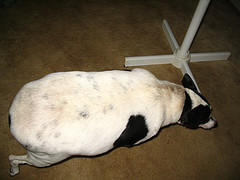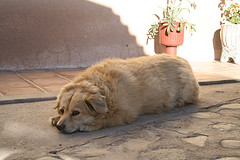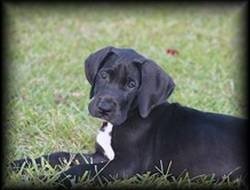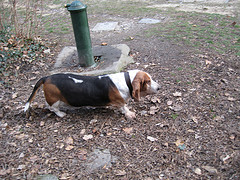|
Fat Dogs
Fat dogs are so cute and cuddly, don't we just love a fat dog? Maybe we love them too much. One in three dogs in the United States is deemed overweight or downright obese, making obesity one of the most common diseases afflicting pets today. 
What’s wrong with fat dogs? Plenty. A combination of too much food and too little exercises creates a recipe for disaster. Obesity can aggravate joint problems, arthritis, and heart disease in dogs. It can shorten your dog's life and will definitely decrease his quality of life. To prove this click here to see the study done form the Purina Pet Institute in St. Louis.
Overweight dogs suffer from many of the same health problems as do overweight humans, including chronic pain and liver disease. Fat dogs are likely to suffer from mobility problems and have a hard time catching their breath. One of the most healthful and humane things you can do for your dog is to keep him from becoming overweight by feeding him the correct amount of food, limiting treats, and providing plenty of exercise opportunities. Many dog owners have a hard time recognizing how easily their pets become obese because the weight gain is gradual. Excess weight can reduce the length of a dog’s life by as much as 20 percent. In humans, this is the equivalent to nearly fifteen years. Have you thought about how many calories one burger with all the trimmings fed to a 40-pound dog is? It is the equivalent of a 150-pound person eating six burgers. If you are unable to resist your pups begging while in the drive through, stash some low-calorie treats in your glove box. An extra 5 pounds may not sound like much, but to a 40-pound dog, it’s the equivalent to a 150-pound person gaining more than 20 pounds.
With some fat dogs, obesity is obvious. They tire easily and have rolls of fat around their necks; drooping abdomens; and wide, barrel shaped bodies. But every dog is different and every breed is different, so it is impossible to have a weight chart determination of obesity. What is a healthy weight for a Labrador Retriever would be overweight for a Greyhound. It is important to monitor your dog’s health and make sure weight gain is not caused by something other than overeating. Sudden weight gain, as well as sudden weight loss, can be a sign of a medical problem. If you suspect your dog is overweight, schedule a visit with your vet for a professional opinion and advice on how to treat your dog’s weight problem. For some dogs (as for some people), too much exercise too fast can cause injury. Your vet may advise you to start with a weight-loss formula and gradually incorporate more activity into your dog’s schedule.
Tips for Cutting Calories
- Use a measuring cup to provide an accurate base line. Level off each scoop of food before pouring it into your dog's bowl.
- Don't feed the same amount year round. Your dog is not as active in winter as in summer. Portion size should be smaller during the winter.
- Keep a dog-feeding dariy for a week or so, write down everything you feed your dog. You may be surprised by the amount and the types of foods he gets. The number of treats (and their calories)can really add up.
- Instead of feeding him once or twice a day, feed him three or four mini meals. By spreading the food intake throughout the day, you are helping your do to better digest the foods. The mere act of eating burns 10 to 15 percent of ingested calories. But remember, these are MINI meals, stay at or below your dog's daily portion needs.
- Fiber fools dogs because it provides a feeling of fullness without a lot of calories. Fiber, an indigestible carbohydrate, cruises through the digestive system without being absorbed by the body, but it plays many major roles. Good sources of fiber are: apples, baked potatoes, bananas, broccoli, green beans, and any dog's favorite peanut butter.
- Instead of giving fatty treats switch to healty treats like: popcorn (my dogs love popcorn), apple slices, raw carrots or cauliflower, and ice cubes. One healthy weight strategy calls for adding more steamed vegetables to your dog's chow and less fatty meat. The vegetables are low in calories and help satisfy your dog's appetite and leave her fulling full.
- Another tip is to replace one-third of your dog's regular dog food with canned pumpkin (not a slice of pumpkin pie). Canned pumpkin is nutritious and provides a feeling of fullness.
- Take her out for a walk. Not only is this good for you but it is much need exercise for you dog as well. Remember, to check with your vet before starting and vigorous exercise regimen.
Here is a Chart you can download to help keep track of your feeding and exercise regimens. Slim Down
Food that are Poisonous to Dogs
- Chocolate:
Chocolate contains two substances harmful to dogs; theobromine and caffeine. Both of these substances occur in only a small amount in milk chocolate but are much more concentrated in baker’s chocolate. The darker and less sweet the chocolate, the more dangerous it is for dogs. Milk chocolate adulterated with sugar and other ingredients, such as M&Ms, may result in mild to severe diarrhea depending on the amount eaten. Dark chocolate, which more of us are eating and cooking with these days, affect the dog’s nervous system and could cause hyperexcitability, restlessness, frequent urination, tremors, and vomiting. Severe cases can result in seizures and cardiac arrest, or even death. - Onions and Garlic:
In large quantities, onions and garlic can cause hemolytic anemia. Ingesting a small amount of garlic is harmless; it is an ingredient used in many dog treats. Onions are more potent. While your dog may tolerate eating bits of meat cooked in onion, do not actually feed your dog the cooked onion pieces or onion-infused broth. - Raisins and Grapes:
According to the ASPCA Animal Poison Control Center, grapes and raisins have caused numerous cases of poisoning when ingested by dogs for as yet unknown reasons. Dogs typically experience lethargy, vomiting, diarrhea, and eventually renal failure. While many dogs eat the occasional grape as a treat without a problem, keep dogs away grape vines or from eating an entire bunch of grapes. Do not ever feed raising to your dog; even small servings of raisings have been linked to toxic reactions, and raisins are not good for canine dental health, either. - Alcohol:
Dogs absorb alcohol quickly and are prone to toxic reactions such as inebriation, seizures, arrhythmias of the heart, low body temperature, kidney damage, and even coma or death. Never give any form of alcohol to your dog.

Purina Pet Institute  Researchers at the Purina Pet Institute in St. Louis, in collaboration with scientists from several major universities, published results of a 14-year study that shows that a dog's median life span can potentially be extended by 15 percent when the dog is kept to its ideal body condition by carefully monitoring food intake. "We all know that obesity, whether human or canine, is bad for health," says Dennis F. Lawler, DVM, a veterinary scientist who, along with principal investigator Richard D. Kealy, PhD, directed the Purina Lifespan study. "What's exciting about this study is that, for the first time, we have shown scientifically that by simply feeding to maintain the ideal body condition throughout a dog's life, we can increase length of life while delaying the visible signs of aging. That's powerful stuff." The only difference: food quantity. One dog in each pair was fed 25 percent less food per day than its mate. The study, which was published in the Journal of the American Veterinary Medical Association (May 1, 2002), revealed the following results: - # Dogs who ate 25 percent fewer calories than their littermates maintained a lean or ideal body condition, resulting in a median life span that was 15 percent (or nearly 2 years) longer than the dogs who ate more food.
- # By age 10, seven dogs in the control group had died, compared with only three lean-fed dogs.
- # By age 13, only one control dog was still alive, as compared with 11 lean-fed dogs.
- # By age 13.5 years, no dogs in the control group were alive, but 25 percent of the lean-fed dogs had survived.
- # The lean-fed dogs did not require treatment for osteoarthritis until a median age of 13.3 years, fully 3 years later than the dogs in the control group.
"It is clear that there are a number of health problems frequently associated with overeating and obesity--both in dogs and in people," explains Weindruch. "From this study, we can extrapolate that large mammals, including humans, can potentially live healthier and longer lives through reasonable diet restriction."
Resources: Dog Bible by Bowtie Press and Obesity A DogFancy Book and Prevention
Table of Contents
|
Click Here To Visit Kittys Corner
 Click Here to Vote for My Site! Click Here to Vote for My Site!
Many dogs overeat if allowed unlimited access to food. This tendency may have its foundation in the gorging behavior of dogs wild ancestors, who had to made one meal last several days.
Homemade Treat Cheddar Lover’s Biscuits - 2 cups unbleached white flour
- ½ cup low-fat cheddar cheese, shredded
- 1 teaspoon garlic powder (do not use fresh garlic)
- ¼ cup vegetable oil
- ¼ cup water
In a large bowl, mix all the ingredients. Knead the dough on a floured surface. Roll out the dough on a lightly floured surface to ½-inch thick. Cut out shapes with a cookie cutter. Place the biscuits on a baking sheet, ½ inch apart. Bake at 400 degrees for 15 to 20 minutes. When done, the biscuits should be firm to the touch. Turn the oven off, and leave the biscuits in for 1 to 2 hours to harden. Yield approximately 40 two-inch biscuits.
Food Bowl Tips Keep your dog fit and healthy by following these tips: - Ask your veterinarian if your dog's body condition is ideal. If not, work with your vet to set up a weight loss plan to return him to that goal condition.
- Read the food label for recommended daily portions based on your dog's weight, and look at the package back for an illustration of a dog at ideal body condition to see if your dog matches up. It's more important to feed your dog to his ideal body condition than to a certain weight.
- Feed the dog, not the bowl. Use a measuring cup when scooping the dry food into the food bowl, so you know exactly how much you are serving. Get a smaller bowl if you think it looks too empty.
- Perform a weekly check on your dog to make sure you can easily feel his ribs. Examine his profile to see if his abdomen is tucked behind the rib cage, and stand over him to see if he has a clearly defined waist behind the ribs.
- Adjust the amount you serve your dog to maintain ideal body condition. No matter what he weighs, if body condition is at the ideal point, the weight will be acceptable.
- Warm up your dog's muscles by starting with a 5-minute slow pace. Then take a 10- to 15-minute brisk walk, ending with a 5-minute slow pace to cool down the muscles.
- Keep your dog on a brisk pace for the majority of the walk, so that he trots rather than saunters. This gait exercises both sides of your dog's body and provides him with a cardiovascular workout.
- Aim for 20-minute daily walks rather than hour-long walks on weekends. A little exercise every day is better than a lot of exercise once or twice a week.

~Kittys Corner~
I have a Female Great Dane and her name is Kitty. She will be 2 in July '10. Her mother is a Blue Dane and her dad is a Black Dane. This is a picture of her here and there are lots of pictures of her on this website. This space is called Kittys Corner because when ever I am at my computer working (which is most of the time) Kitty is laying or sitting beside me with her head on my lap. So I made her a corner so she can voice what is going on in her world.
~Enjoy~
The weather is so warm and sunny. I was getting tired of the cold and being stuck in the house. Now mom has been back taking me on our walks I missed our walks. Have you been doing anything fun lately? Will you send me your pictures so I can see them? Mom even said something about starting a contest. How fun! So start taking some pictures, or if you already have some, send them in so I can see them. Send in a Picture
|




 Click Here to Vote for My Site!
Click Here to Vote for My Site!






